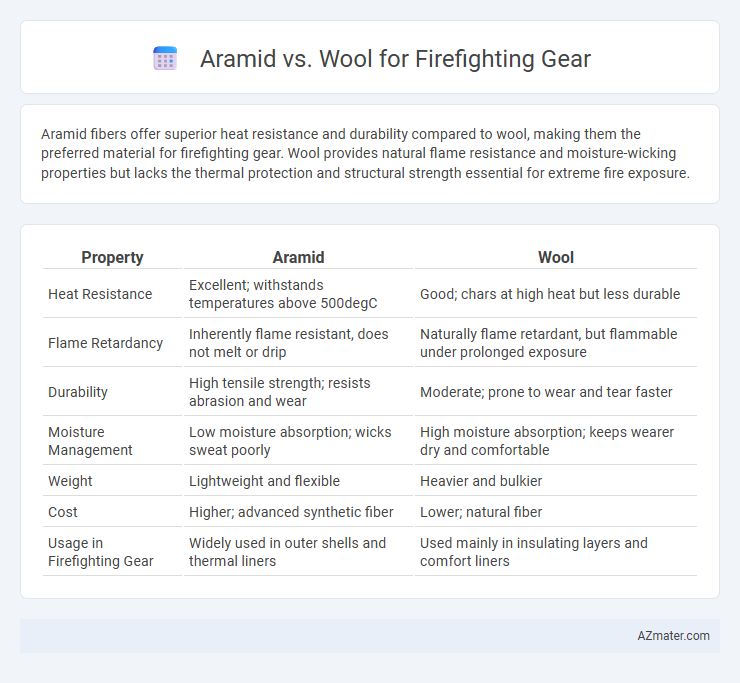Aramid fibers offer superior heat resistance and durability compared to wool, making them the preferred material for firefighting gear. Wool provides natural flame resistance and moisture-wicking properties but lacks the thermal protection and structural strength essential for extreme fire exposure.
Table of Comparison
| Property | Aramid | Wool |
|---|---|---|
| Heat Resistance | Excellent; withstands temperatures above 500degC | Good; chars at high heat but less durable |
| Flame Retardancy | Inherently flame resistant, does not melt or drip | Naturally flame retardant, but flammable under prolonged exposure |
| Durability | High tensile strength; resists abrasion and wear | Moderate; prone to wear and tear faster |
| Moisture Management | Low moisture absorption; wicks sweat poorly | High moisture absorption; keeps wearer dry and comfortable |
| Weight | Lightweight and flexible | Heavier and bulkier |
| Cost | Higher; advanced synthetic fiber | Lower; natural fiber |
| Usage in Firefighting Gear | Widely used in outer shells and thermal liners | Used mainly in insulating layers and comfort liners |
Introduction to Firefighting Gear Materials
Aramid fibers, such as Nomex and Kevlar, are widely used in firefighting gear due to their exceptional flame resistance, high tensile strength, and thermal stability. Wool offers natural flame retardant properties and moisture-wicking capabilities, but lacks the durability and heat resistance of aramid materials under intense fire exposure. Modern firefighting gear typically incorporates aramid blends to ensure maximum protection and comfort in high-temperature environments.
Overview of Aramid Fibers
Aramid fibers, such as Nomex and Kevlar, are synthetic materials renowned for their exceptional heat resistance and durability, making them ideal for firefighting gear. These fibers provide superior thermal protection by maintaining structural integrity at temperatures exceeding 400degC, significantly reducing burn injuries. Unlike wool, aramid fibers offer enhanced flame retardancy, abrasion resistance, and lighter weight, optimizing firefighter safety and comfort during extended operations.
Properties of Wool in Protective Clothing
Wool in firefighting gear offers natural flame resistance, excellent moisture management, and thermal insulation, maintaining comfort during exposure to heat and sweat. Its ability to char rather than melt reduces the risk of severe burns, making it a dependable protective fabric. Wool's durability and breathability complement synthetic fibers like aramid to enhance overall safety and performance in hazardous environments.
Fire Resistance: Aramid vs Wool
Aramid fibers, such as Kevlar and Nomex, offer superior fire resistance compared to wool, with inherent flame-retardant properties and high thermal stability that prevent ignition and reduce heat transfer during firefighting operations. Wool, while naturally flame-resistant and capable of self-extinguishing once removed from a heat source, lacks the durability and high-temperature protection of aramid fabrics. Aramid's performance in maintaining structural integrity at extreme temperatures makes it the preferred choice for firefighting gear requiring advanced fire resistance.
Thermal Insulation Capabilities
Aramid fibers, such as Nomex and Kevlar, provide superior thermal insulation in firefighting gear due to their inherent flame resistance and ability to maintain structural integrity at temperatures exceeding 370degC (700degF). Wool offers natural thermal insulation by trapping air within its fibers, but it is less effective under extreme heat and tends to char rather than resist flames. The advanced heat resistance and durability of aramid materials make them the preferred choice for protective clothing in high-risk fire environments.
Comfort and Breathability Comparison
Aramid fibers, commonly used in firefighting gear, provide excellent heat resistance but tend to be less breathable and can retain heat, causing discomfort during extended use. Wool offers natural moisture-wicking properties and breathability, enhancing comfort by regulating temperature and reducing sweat accumulation. However, wool's flame resistance is lower than aramid, making aramid blends often preferred to balance protection, comfort, and breathability in firefighting apparel.
Durability and Longevity in Firefighting Conditions
Aramid fibers like Nomex exhibit exceptional durability and heat resistance, maintaining structural integrity under high-temperature exposure, which makes them ideal for firefighting gear. Wool offers natural flame resistance and moisture-wicking properties but lacks the same level of abrasion resistance and long-term heat durability as aramid materials. Firefighting gear constructed with aramid delivers superior longevity, enduring multiple exposures to flames, heat, and rough conditions without significant degradation.
Cost and Availability of Aramid and Wool Gear
Aramid firefighting gear, known for its high heat resistance and durability, generally comes at a higher cost compared to wool gear, impacting budget considerations for fire departments. Wool gear, while less expensive and more widely available, offers moderate fire resistance and durability, making it a more accessible option in some regions. The availability of aramid gear is often limited to specialized suppliers, whereas wool gear benefits from broader market presence and easier procurement.
Environmental Impact and Sustainability
Aramid fibers, commonly used in firefighting gear, offer durability and heat resistance but have a higher environmental footprint due to energy-intensive production and limited biodegradability. Wool, a natural and renewable resource, provides excellent thermal insulation and is biodegradable, reducing long-term environmental impact. Choosing wool-enhanced blends or recycled aramid fabrics can improve sustainability while maintaining protective performance.
Choosing the Right Material for Firefighting Gear
Aramid fibers such as Nomex provide superior heat and flame resistance, making them an essential choice for firefighting gear designed to withstand extreme temperatures and direct flame exposure. Wool offers natural insulating properties and comfort, but it lacks the enhanced thermal protection and durability found in aramid blends. Prioritizing materials like aramid ensures optimal firefighter safety through enhanced flame retardancy, thermal stability, and long-lasting performance in hazardous environments.

Infographic: Aramid vs Wool for Firefighting Gear
 azmater.com
azmater.com